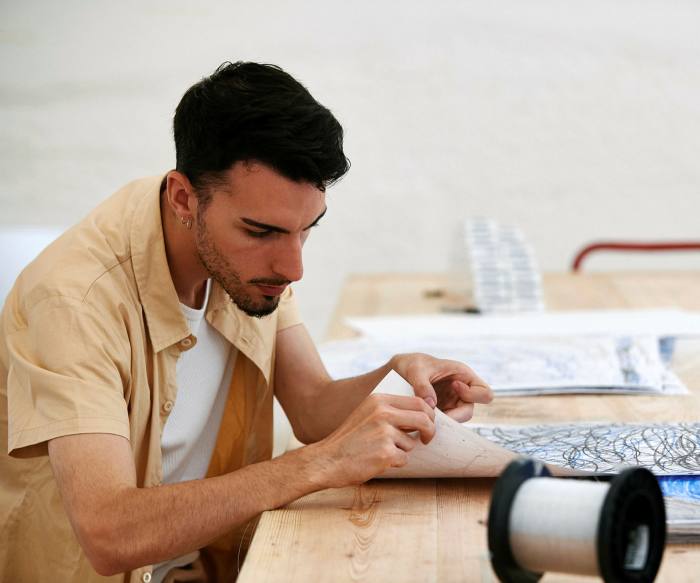The megalith commercial art gallery is a 21st-century phenomenon. With their multiple locations across the world, they sometimes resemble property empires as much as places for the sale of art. Representing dozens of living artists and the estates of others, their size and value are unprecedented. Yet although the model is a new one, old-fashioned business empires come to mind: these huge galleries often have a charismatic figurehead; legacy arrangements are kept in the family.
They can, to some extent, invent their business model as they go along — for instance, a sudden lurch into NFTs or accepting payment in crypto. All offer a range of goodies: films, books, events. Some — David Zwirner and Gagosian, for example — have become significant publishers of art books. In the case of Hauser & Wirth, whose new Paris gallery brings the number of its sites to 18, snapping at the heels of Gagosian’s 19, the model is more diverse, with restaurants and cafés, a hotel, merchandise. It specialises in converting historic buildings; in Bruton in Somerset and Menorca in the Balearic Islands, which opened in 2021, they have created remarkable gardens.
In those two sites, as well as at the gallery’s New York and Los Angeles branches, there’s also an emphasis on community engagement and learning. This is the passion project of Manuela Wirth, co-director with her husband Iwan and Marc Peyot, says the gallery’s education director, Debbie Hillyerd, when we meet in a café in Menorca’s capital, Mahon.
“There are three pillars to our thinking: community, academic and career access — meaning that gap between when you leave school and [enter] the working world,” she says. The community projects involve local groups of all sorts, as well as aiming at harder-to-reach demographics. The academic strand centres around schools and students, while career access brings young people into the gallery’s orbit so they can garner experience for a job in the arts.
Hillyerd and the gallery’s teams have devised crossover programmes encompassing several of their sites. Chillida Leku, an unusual museum and foundation devoted to the Basque country sculptor Eduardo Chillida, is now part of the Hauser & Wirth stable: there is a Chillida sculpture prominent in the Menorcan garden and the Somerset gallery held a Chillida exhibition last year. This was perfect for a cross-gallery learning programme, as Hillyerd puts it, “to educate, inform, give opportunities and let people know what we do — joining the dots and making sense of things”.

In Somerset, an ambitious collaboration with Arts University Bournemouth has created a research and practice project embedded in the chosen students’ degree, all based around the gallery’s current Henry Moore exhibition. And its education work even travels: last year’s inaugural artist in Menorca, the Los Angeleno Mark Bradford, initiated a model of interacting with local students that he has taken home as a scheme for 15-18-year-olds in a South Los Angeles high school.
All aspects of Hauser’s community thinking are engaged in the Menorcan space this year, which is open from May to October. For its second season, Spanish MA students were offered residencies to design the Education Lab, devising activities for schoolchildren and curating the education space — a generous chunk of the gallery’s converted buildings. Hillyerd says she wanted a new programme “driven by the location itself, and not by someone like me, back in the UK”.
Hauser & Wirth put out a call to Spanish universities for MA students to apply for residencies. Among the successful candidates was Carlos López, studying contemporary art history and visual culture in Madrid, who was chosen by Hillyerd and Hauser’s director in Menorca, Mar Rescalvo Pons, to work with the small team on the island. Experience behind the scenes at a major gallery operation and a per diem were balanced by researching, devising and running a two-month programme for the island’s schoolchildren.


The results are delightful — hundreds of vibrant, expressive drawings displayed on wires looped across the ceiling, like huge sails. When the gallery opens to the public next week, with a show by American artist Rashid Johnson, the space will also have books and texts chosen by Johnson for visitors to read, including poetry that he grew up with — and an opportunity for more drawing.
So, will this residency model become an annual event? “Every year we should explore what we want, and be flexible,” Hillyerd says. “We’ve never wanted a didactic programme, we’re not an institution, we want to be responsive to the community. And to what our artists want: the artist is always at the centre of what we do.
“Rashid is a fantastic artist, he really supports learning and different forms of charity work. Our challenge is how to bring that to our audience in Menorca, to use it as a hook to draw people in.”
hauserwirth.com
Credit: Source link









